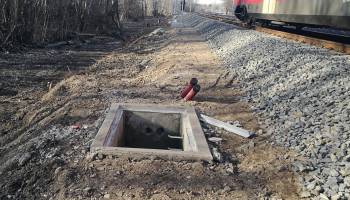The refurbishment of railway lines and the installation of new tracks necessitate the construction of numerous concrete manholes; therefore, the optimization of manholes should be investigated. To this end, the use of innovative materials in addition to advanced design methods with realistic modeling is required. In the case of conservatively designed structures, there exists the possibility of redesigning the structure utilizing suitable fiber-reinforced concrete (FRC) only. The main advantage of synthetic macrofibers over steel is their complete corrosion resistance, which is essential in corrosive environments. Other advantages include their low carbon footprint, reduced construction time, and cost-effectiveness. This paper outlines the optimization process for a conventional cast-in-situ concrete manhole. The imperative for a monolithic construction system stems from the diverse geometries and distinct designs of individual pipe culverts, compounded by the often-challenging accessibility of installation sites. In the optimization phase, synthetic macrofiber reinforcement replaced conventional reinforcing steel bars, using advanced finite element analysis (FEA). The design was not conducted on an equivalent basis, resulting in potential variations in the load-carrying capacity between reinforced concrete (RC) and FRC manholes. Nevertheless, both are deemed suitable for the specified loads. The conventional design method used for RC and the advanced finite element design method used for FRC were scrutinized, taking into account the existing standard environment. Subsequently, a real-scale test was conducted to validate the calculations. Carbon footprint analyses were performed for both the original and proposed solutions, and the results were compared. The solution obtained in this study is unique and pioneering in terms of both the calculation method and the structural design, and the CO2 calculations validate its necessity.

Publications
In our new paper, we present the design process of a synthetic fibre reinforced manhole. After advanced finite element design, the results are validated by real scale test. The carbon footprint of the structure is also calculated and analysed.
DOI:https://doi.org/10.1016/j.cscm.2024.e03093
DOI:https://doi.org/10.1016/j.cscm.2024.e03093
Related articles


